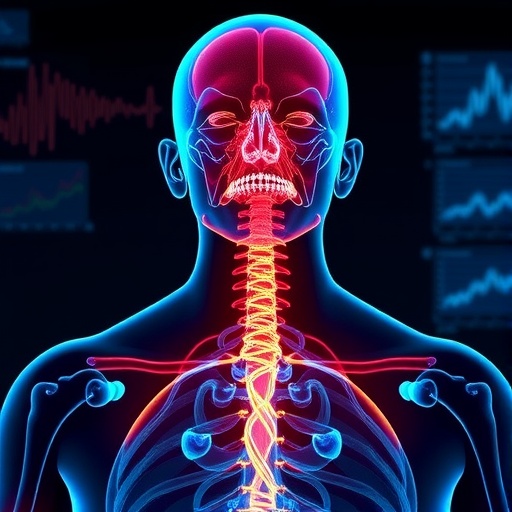Vagus nerve stimulation (VNS) has long been recognized as a groundbreaking therapeutic approach for conditions such as treatment-resistant depression and epilepsy. This bioelectronic treatment involves the delivery of electrical impulses to the vagus nerve, a critical component of the autonomic nervous system responsible for regulating various involuntary physiological functions. While the primary clinical focus of VNS has traditionally been on neural disorders, an intriguing side-effect noted across several studies is its influence on body weight and metabolism. Recent comprehensive research efforts have begun to unravel the profound impact of vagus nerve stimulation beyond its neurological uses, revealing promising avenues for tackling obesity and metabolic disorders through neuromodulation.
In a cutting-edge systematic review and meta-analysis by Shen, Tang, Pan, and colleagues, published in the International Journal of Obesity in 2025, the effects of VNS on metabolism are rigorously examined. Their study integrates data from both preclinical animal models and human clinical trials, providing robust statistical evidence that links VNS to reductions in body weight and changes in appetite regulation. This meta-analysis synthesizes decades of dispersed research and attempts to clarify the physiological mechanisms underpinning this phenomenon. The findings suggest that VNS may modulate metabolic homeostasis through complex pathways involving the gut-brain axis, autonomic nervous system shifts, and hormonal signaling circuits.
The vagus nerve serves as a critical communication highway between the brain and numerous metabolic organs, including the liver, pancreas, and gastrointestinal tract. Electrical stimulation of this nerve appears to alter signals related to satiety, hunger, and energy expenditure, thereby influencing eating behavior and metabolic rate. Animal studies, particularly those involving rats and minipigs, present compelling evidence where VNS leads to consistent weight loss outcomes. These models demonstrate that vagal stimulation results in decreased food intake and enhanced fat oxidation, pointing towards an integrated metabolic response that suppresses appetite and increases energy consumption.
Human clinical trials, though fewer in number, echo these promising results. Patients undergoing VNS therapy for neurological indications often exhibit unintended weight loss, piquing scientific interest in repurposing VNS as a potential obesity treatment. However, the variability in stimulation parameters, patient populations, and endpoints across these trials previously hindered conclusive analysis. The meta-analytic approach by Shen and colleagues statistically harmonizes these heterogeneous datasets, affirming that VNS evokes a significant negative energy balance with promising implications for metabolic disease management.
On the cellular and molecular level, vagus nerve stimulation influences a dynamic interplay of neurotransmitters and hormones such as acetylcholine, norepinephrine, and peptides involved in appetite regulation like ghrelin and leptin. By modulating vagal afferents and efferents, VNS impacts hypothalamic circuits critical for energy homeostasis. This neuromodulatory input reshapes neuroendocrine responses affecting insulin sensitivity and glucose metabolism, suggesting that VNS could concurrently benefit diabetic conditions often associated with obesity.
Moreover, the gut microbiota, now recognized as a major contributor to metabolic health, may also be indirectly influenced by vagus nerve activity. Emerging evidence points to VNS-induced shifts in vagal signaling that modify gastrointestinal motility and secretion, creating an altered habitat for commensal bacteria. These microbial changes could feedback into host metabolism, further amplifying the therapeutic effects of vagus nerve stimulation on weight regulation.
Despite its promising potential, the precise optimization of VNS parameters remains a crucial research challenge. Variations in stimulation frequency, intensity, and timing could differentially affect the autonomic balance between sympathetic and parasympathetic activity, with important metabolic consequences. Personalized VNS protocols tailored to individual patient physiology might maximize efficacy and minimize side effects, but this hypothesis awaits systematic exploration.
Furthermore, although weight loss observed during VNS treatment is generally seen as beneficial, especially in the context of obesity, it is vital to assess the long-term safety and metabolic impacts comprehensively. Unintended excessive weight loss or disruptions in nutrient absorption could pose risks, underscoring the need for carefully controlled clinical trials aimed at establishing standardized treatment guidelines.
The authors of the meta-analysis emphasize that the integration of neurophysiology and metabolism through vagus nerve stimulation represents a paradigm shift in our approach to metabolic diseases. Instead of targeting single receptors or enzymes pharmacologically, VNS offers a whole-organism neuromodulatory strategy that could simultaneously address multiple dysregulated pathways. Such holistic intervention aligns with the increasing recognition of metabolic disease complexity, which often resists single-target therapies.
Given the global epidemic of obesity and associated comorbidities like type 2 diabetes and cardiovascular disease, innovative treatments are urgently needed. Vagus nerve stimulation, with its dual neurological and metabolic benefits, offers a tantalizing new frontier. Ongoing research endeavors are currently exploring next-generation VNS devices with closed-loop feedback mechanisms, enabling real-time adjustment of stimulation according to physiological signals.
In practice, these developments hold significant promise for expanding VNS application from primarily neurological disorders to metabolic medicine. However, achieving regulatory approval and clinical adoption for obesity indications will require robust evidence from large-scale, randomized controlled trials with long-term follow-up. Additionally, multidisciplinary collaboration among neuroscientists, endocrinologists, and bioengineers will be essential to translate mechanistic findings into effective therapies.
In conclusion, the systematic review and meta-analysis conducted by Shen et al. illuminates the multifaceted role of vagus nerve stimulation as a metabolic modulator. By bridging insights from animal research and human clinical data, their work highlights VNS as a versatile tool capable of modulating appetite, energy expenditure, and metabolic homeostasis. This evolving understanding opens exciting possibilities for tackling obesity and its complications through neuromodulation, redefining how we conceive future therapies for complex metabolic disorders.
As new bioelectronic medicine platforms emerge, vagus nerve stimulation exemplifies the potential to harness the body’s intrinsic regulatory networks for therapeutic benefit. The ongoing elucidation of its mechanisms will undoubtedly enhance our capacity to combat the growing burden of metabolic disease in an increasingly health-conscious world.
Subject of Research: Effects of vagus nerve stimulation on metabolism and weight regulation
Article Title: Effect of vagus nerve stimulation on metabolism: a systematic review and meta-analysis
Article References:
Shen, T., Tang, X., Pan, Y. et al. Effect of vagus nerve stimulation on metabolism: a systematic review and meta-analysis. Int J Obes (2025). https://doi.org/10.1038/s41366-025-01871-w
Image Credits: AI Generated
DOI: https://doi.org/10.1038/s41366-025-01871-w




